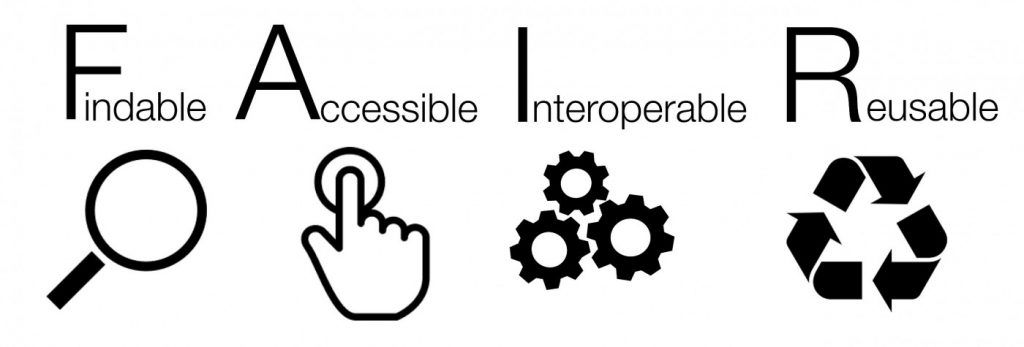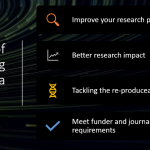
FAIR guiding principles for data resources (SanguaPundir 2016) CC-BY-SA
FAIR aims to improve the value and impact of research data by ensuring it is Findable, Accessible, Interoperable and Re-useable. All data produced by researchers at BU should be FAIR, and many journals and funders have made it a condition for successful submission or grant applications. Over a series of posts I will look at each one and explain what this means for the data you produce.
Findable
Data can only be used to validate findings or to make new discoveries if it can be found in the first place. How do you ensure your data is visible?
- At the conclusion of your research project, deposit your data in a suitable repository. Preferably this would be in a disciplinary repository recognised by your research community. Some funders and publishers will specify which repository they want. You need to be aware that some repositories charge for their services, so you need to take this into account in the planning stages if bidding for funding. The Registry of Research Data Repositories (re3data) is a good place to look.
- BU’s own data repository (BORDaR) is an option if no suitable alternative is available. There is no charge, and a Digital Object Identifier (DOI) will be generated which you can pass on to publishers to link any outputs to the original data. Even if data is deposited in an external repository, a record is created in BORDaR to link to it. This will make your data visible to anyone browsing/searching for data created by BU researchers. You will need to email bordar@bournemouth.ac.uk so we can create the record.
- Data in a repository is still effectively hidden if it is not provided with descriptive information (metadata) that can be picked up by search engines or people browsing. For example, consider:
- Giving your dataset and file names descriptive titles. A title like ‘project data’ is not going to be terribly useful to anyone browsing a list of results.
- Use controlled vocabularies, where available, to assign keywords to your data.
- Provide an abstract that explains clearly what the data is and how it was used in your context.
If you were looking for datasets to support a future research project, what sort of information would you need to see to make the task as easy as possible?
For more information visit the Library’s Research Data Management guide or email bordar@bournemouth.ac.uk.
Dan Bailyes
Faculty Librarian (FMC) and LLS lead for Research Data Management (RDM)
References
SanguaPundir., 2016. FAIR guiding principles for data resources [image]. Wikimedia Commons. Available from: https://commons.wikimedia.org/wiki/File:FAIR_data_principles.jpg [Accessed 08 July 2021].
 Benefits of depositing your data
Benefits of depositing your data










 Dr. Chloe Casey on Sky News
Dr. Chloe Casey on Sky News Final Bournemouth University publication of 2025
Final Bournemouth University publication of 2025 On Christmas Day in the Morning…
On Christmas Day in the Morning… New Nepal scoping review on maternal & neonatal health
New Nepal scoping review on maternal & neonatal health ECR Funding Open Call: Research Culture & Community Grant – Application Deadline Friday 12 December
ECR Funding Open Call: Research Culture & Community Grant – Application Deadline Friday 12 December MSCA Postdoctoral Fellowships 2025 Call
MSCA Postdoctoral Fellowships 2025 Call ERC Advanced Grant 2025 Webinar
ERC Advanced Grant 2025 Webinar Horizon Europe Work Programme 2025 Published
Horizon Europe Work Programme 2025 Published Horizon Europe 2025 Work Programme pre-Published
Horizon Europe 2025 Work Programme pre-Published Update on UKRO services
Update on UKRO services European research project exploring use of ‘virtual twins’ to better manage metabolic associated fatty liver disease
European research project exploring use of ‘virtual twins’ to better manage metabolic associated fatty liver disease